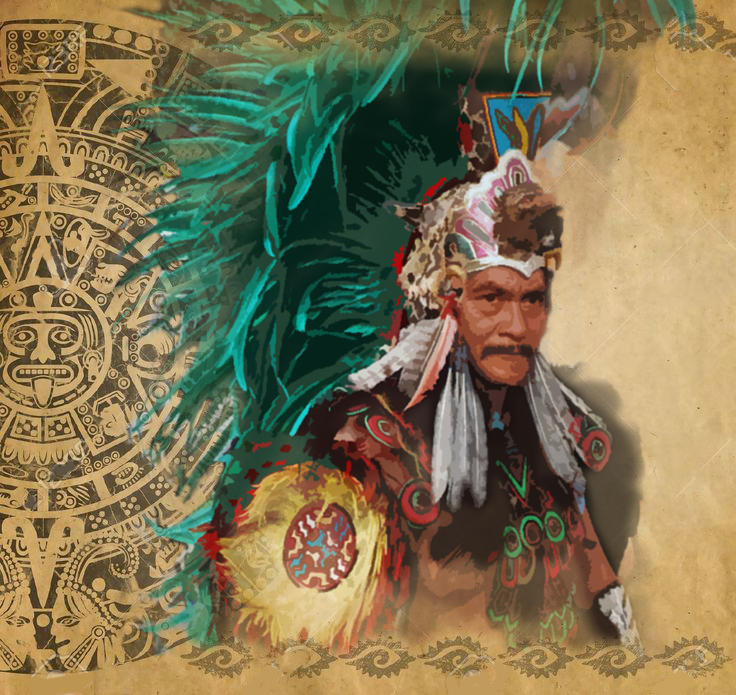
Summary by Christopher Minster
Cuauhtémoc, the last Aztec ruler, is a bit of an enigma. Even though the Spanish conquistadors under Hernan Cortes held him in captivity for two years before executing him, not a lot is known about him. As the last Tlatoani or Emperor of the Mexica, dominant culture in the Aztec Empire, Cuauhtémoc fought bitterly against the Spanish invaders but lived to see his people defeated, their magnificent capital city of Tenochtitlan burned to the ground, their temples looted, desecrated and destroyed.
When the Cortes expedition first turned up on the shores of the Gulf Coast, many of the Aztecs did not know what to make of them. Were they gods? Men? Allies? Enemies? Chief among these indecisive leaders was Montezuma Xocoyotzin, Tlatoani of the Empire. Not so Cuauhtémoc. From the first, he saw the Spanish for what they were: a grave threat unlike any the Empire had ever seen. He opposed Montezuma’s plan of allowing them into Tenochtitlan and fought fiercely against them when his cousin Cuitlahuac replaced Montezuma. His unfailing distrust and hatred of the Spanish helped his rise to the position of Tlatoani upon the death of Cuitlahuac.
Once he was in power, Cuauhtémoc pulled out all the stops to defeat the hated Spanish conquistadors. He sent garrisons to key allies and vassals to prevent them from switching sides. He attempted without success to convince the Tlaxcalans to turn on their Spanish allies and massacre them. His generals nearly surrounded and defeated a Spanish force including Cortes at Xochimilco. Cuauhtémoc also ordered his generals to defend the causeways into the city, and the Spaniards assigned to attack that way found the going very difficult.
The Mexica were led by a Tlatoani: the word means “he who speaks” and the position was roughly equivalent to Emperor. The position was not inherited: when one Tlatoani died, his successor was selected from a limited pool of Mexica princes who had distinguished themselves in military and civic positions. Usually, the Mexica elders selected a middle-aged Tlatoani: Montezuma Xocoyotzin was in his mid-thirties when he was selected to succeed his uncle Ahuitzotl in 1502. Cuauhtémoc’s exact date of birth is unknown but believed to be about 1500, making him only twenty years old when he ascended to the throne.
After the death in late 1520 of Cuitlahuac, the Mexica needed to select a new Tlatoani. Cuauhtémoc had much going for him: he was brave, he had the right bloodline and he had long opposed the Spanish. He also had one other advantage over his competition: Tlatelolco. The district of Tlatelolco, with its famous market, had once been a separate city. Although the people there were also Mexica, Tlatelolco had been invaded, defeated and absorbed into Tenochtitlan around 1475. Cuauhtemoc’s mother had been a Tlatelolcan princess, son of Moquíhuix, last of the independent rulers of Tlatelolco, and Cuauhtémoc had served on a council that oversaw the district. With the Spanish at the gates, the Mexica could not afford a division between Tenochtitlan and Tlatelolco. Cuauhtemoc’s selection appealed to the people of Tlatelolco, and they fought bravely until he was captured in 1521.
Shortly after he was captured, Cuauhtémoc was asked by the Spanish what had become of the fortune in gold, silver, gems, feathers and more than they had left behind in Tenochtitlan when they had fled the city on the Night of Sorrows. Cuauhtémoc denied having any knowledge about it. Eventually, he was tortured, along with Tetlepanquetzatzin, the Lord of Tacuba. When the Spanish were burning their feet, the lord of Tacuba allegedly looked to Cuauhtémoc for some sign that he should talk, but the former Tlatoani merely bore the torture, reportedly saying “Am I enjoying some kind of delight or bath?” Cuauhtémoc eventually told the Spanish that before the loss of Tenochtitlan he had ordered the gold and silver thrown in the lake: the conquistadors were only able to salvage a few trinkets from the muddy waters.
On August 13, 1521, as Tenochtitlan burned and the Mexica resistance had dwindled to a few handfuls of dogged fighters scattered around the city, a lone war canoe tried to escape the city. One of Cortes’ brigantines, captained by Garcí Holguín, sailed after it and captured it, only to find that Cuauhtémoc himself was on board. Another brigantine, captained by Gonzalo de Sandoval, approached, and when Sandoval learned that the emperor was on board, he demanded that Holguín hand him over so that he, Sandoval, could turn him over to Cortes. Although Sandoval outranked him, Holguín refused. The men bickered until Cortes himself took charge of the captive.
According to eyewitnesses, when Cuauhtémoc was captured, he dejectedly asked Cortes to kill him, pointing the dagger the Spaniard wore. Eduardo Matos, the eminent Mexican archaeologist, has interpreted this action to mean that Cuauhtémoc was asking to be sacrificed to the gods. As he had just lost Tenochtitlan, this would have appealed to the defeated emperor, as it offered a death with dignity and meaning. Cortes refused and Cuauhtémoc lived on for four more miserable years as a prisoner of the Spanish.
Cuauhtémoc was a prisoner of the Spanish from 1521 until his death in 1525. Hernan Cortes feared that Cuauhtemoc, a brave leader revered by his Mexica subjects, could start a dangerous rebellion any time, so he kept him under guard in Mexico City. When Cortes went to Honduras in 1524, he brought Cuauhtémoc and other Aztec nobles with him because he was afraid to leave them behind. When the expedition was camped near a town called Itzamkánac, Cortes began to suspect that Cuauhtémoc and the former lord of Tlacopan were hatching a plot against him and he ordered both men hanged.

